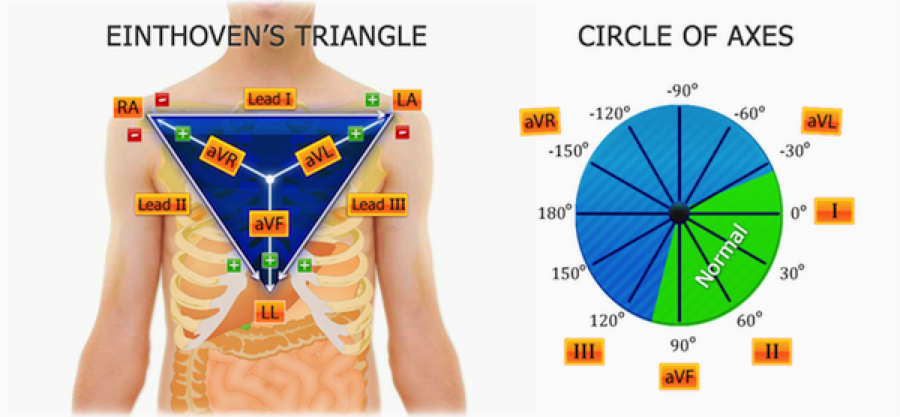Topic inspired by Dr. Jordan Smedresman’s (EM-3) ECG of the Block, November 4th 2015.

Your patient in room 11 in the green zone has chest pain/shortness of breath + ST segment elevation (STE) in lead aVR and diffuse ST segment depression (STD).
STE in aVR can be indicative of:
- Left main coronary artery (LMCA) occlusion/critical stenosis
- Proximal LAD occlusion/critical stenosis
- Triple vessel disease
Or:
- Anything that can cause severe global ischemia; GI bleed, massive PE, SVT, ect.
Treatment considerations:
- The intervention for 2 of the 4 situations above (left main and triple vessel disease) needs coronary artery bypass grafting (CABG). If you’ve given Clopidogrel as part of your treatment, their bleeding risk during surgery has skyrocketed because of prolonged platelet inhibition.
- STE in aVR > 1mm was a strong predictor of severe left main/3 vessel disease. These patients need a CABG and should not receive platelet inhibitors (Kosuge 2011).
Physiology:
- The occlusion versus stenosis differentiation is an important one. Dr. Smith makes the point that, “it really just signifies widespread and diffuse subendocardial ischemia.” Left main artery OCCLUSION is usually fatal.
- STE in aVR is not a STEMI in lead aVR; rather the STE in aVR is a reciprocal change to a leftward and inferior ST depression axis caused by diffuse subendocardial ischemia (notice the diffuse ST depression in the EKG above).

Normal Variants; i.e. demand ischemia.
- STE in aVR in presence of a supraventricular tachycardia.

- Severe HTN can produce STE in aVR. Common in patients with bad left ventricular hypertrophy.
- STE in aVR can also be caused by any cause of severe generalized global ischemia; severe anemia (e.g. GI Bleeding), type A dissection, massive PE, carbon monoxide poisoning etc.
- Can also be a normal variant in left bundle branch block (LBBB)
Treat the oxygen supply and demand issue prior to diagnosing acute coronary syndrome. Reassess. If persistent ischemia, then it’s ACS. Sending a patient with acute pulmonary edema to the cath lab while they should be in the resuscitation bay on bilevel positive airway pressure and a nitroglycerine drip likely not best for your patient. If blood pressure and oxygenation controlled, and still with an ischemic ECG, then send to cath lab.
REFERENCES:
#FOAMed
Burns, Edward, ‘ST Elevation in aVR – LMCA Occlusion’ Life in the Fast Lane.
Rezaie, Salim, ‘Lead aVR: The Forgotten 12th Lead’ Academic Life in Emergency Medicine. June 20th 2013
Dr. Smith’s ECG Blog ‘STE in aVR and diffuse ST depression: It can be ACS or demand ischemia. If ACS, either posterior STEMI or subendocardial ischemia!’ November 16, 2015
Dr. Smith’s ECG Blog ‘ST Elevation in Lead aVR, with diffuse ST depression, does not represent left main occlusion’ August 2, 2014
ECG Weekly – Amal Mattu’s Case of the Week, November 9, 2015
Scholarly articles:
Kosuge M, Ebina T, Hibi K, et al. An early and simple predictor of severe left main and/or three-vessel disease in patients with non-ST-segment elevation acute coronary syndrome. Am J Cardiol. 2011 Feb 15;107(4):495-500.
Kosuge M, Uchida K, Imoto K, et al. An early and simple predictor of severe left main and/or three-vessel disease in patients with non-ST-segment elevation acute coronary syndrome. J Am Coll Cardiol. 2015 Jun 16;65(23):2570-1.
Nikus KC, Eskola MJ. Electrocardiogram patterns in acute left main coronary artery occlusion. J Electrocardiology. 2008 Nov-Dec;41(6):626-9.
Nikus K, Pahlm O, Wagner G, et al. Electrocardiographic classification of acute coronary syndromes: a review by a committee of the International Society for Holter and Non-Invasive Electrocardiology. 2010 Mar-Apr;43(2):93, 97-98.
Rokos IC, French WJ, Mattu A, et al. Appropriate cardiac cath lab activation: optimizing the electrocardiogram interpretation and clinical decision making for acute ST-elevation myocardial infarction. Am Heart J. 2010 Dec; 160(6):995-1003.
Taglieri, N., Marzocchi, A., Saia, F., et al. Short- and Long-Term Prognostic Significance of ST-Segment Elevation in Lead aVR in Patients With Non–ST-Segment Elevation Acute Coronary Syndrome. Am J Cardiol. 2011.
Wagner GS, Macfarlane P, Wellens H, et al. AHA/ACCF/HRS recommendations for the standardization and interpretation of the electrocardiogram: Part VI: acute ischemia/infarction: a scientific statement from the American Heart Association Electrocardiography and Arrhythmias Committee, Council on Clinical Cardiology; the American College of Cardiology Foundation; and the Heart Rhythm Society. J Am Coll Cardiol. 2009 Mar 17;53(11):1007.
Williamson K, Mattu A, Plautz CU, et al. Electrocardiographic applications of lead aVR. Am J Emerg Med. 2006 Nov;24(7):864-74.